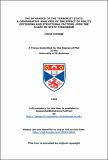Files in this item
The dynamics of the terrorist state : a comparative analysis of the effect of policy decisions and structural factors upon the shape of state terrorism
Item metadata
| dc.contributor.advisor | Wilkinson, Paul | |
| dc.contributor.author | Claridge, David | |
| dc.coverage.spatial | ix, 365 p. | en_US |
| dc.date.accessioned | 2016-04-05T16:09:13Z | |
| dc.date.available | 2016-04-05T16:09:13Z | |
| dc.date.issued | 1999 | |
| dc.identifier | uk.bl.ethos.682793 | |
| dc.identifier.uri | https://hdl.handle.net/10023/8561 | |
| dc.description.abstract | This study employs Alexander George's 'structured, focused comparison' methodology for small-N comparative analysis, in an attempt to address some of the gaps in the theoretical literature on state terrorism. An examination of that literature, both in the historical and social science traditions, highlights various attempts to theorise about the processes by which states attempt to influence the behaviour of their domestic populations through violence. However, these have overwhelmingly concentrated upon the question of why state terrorism occurs. The question of how states terrorise has rarely been considered. This study, then, is a heuristic evaluation of the process of terror after the decision to initiate it has been taken. It is suggested that solutions that will help to ameliorate the human suffering and destabilisation caused by state terrorism are likely to emerge from within the international community. However, in order for the various governmental and non-governmental international organisations to tackle the issue they must fully understand the dynamics of terrorist states. A definitional model of state terrorism is developed, building upon existing concepts of state and sub-state violence. The model is then used to identify appropriate cases for further examination. A number of potential cases are highlighted, with Indonesia and East Timor (1975-1995) and Guatemala (1978-1995) finally being selected. A research design is formulated to examine the cases in the context of existing theory. In conducting the case studies according the research design it is postulated that while the initial impetus for state terrorism must come from the regime, the most effective means of ensuring an efficient terror campaign is to create semi-autonomous units with a direct overlap of responsibility. These units are then allowed to innovate in their selection of targets and tactics. It is noted that states are sensitive to pressure from the international community, and will often respond by disbanding offending units in an attempt to de-escalate violence. However, the perpetrators of human rights violations are rarely punished. Impunity is the engine of state terrorism. It is concluded that the broader realist tradition of international relations provides a revealing framework to assist our understanding of how states react to extreme challenges to their domestic authority. It is argued that in conducting wars against their own populations states mimic the conditions of the international environment. Likewise, the most powerful players in the international community (other states) respond according to concerns of power politics. It is concluded that only by providing independent international bodies to tackle impunity, such as an International Criminal Court, can state terrorism be undermined. | en_US |
| dc.language.iso | en | en_US |
| dc.publisher | University of St Andrews | |
| dc.subject.lcsh | Terrorism | en |
| dc.title | The dynamics of the terrorist state : a comparative analysis of the effect of policy decisions and structural factors upon the shape of state terrorism | en_US |
| dc.type | Thesis | en_US |
| dc.accrualMethod | HV6431.C6 | |
| dc.contributor.sponsor | Economic and Social Research Council (ESRC) | en_US |
| dc.type.qualificationlevel | Doctoral | en_US |
| dc.type.qualificationname | PhD Doctor of Philosophy | en_US |
| dc.publisher.institution | The University of St Andrews | en_US |
This item appears in the following Collection(s)
Items in the St Andrews Research Repository are protected by copyright, with all rights reserved, unless otherwise indicated.

